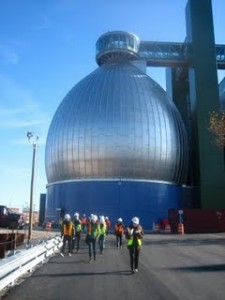Mary Wood’s “What Would Gordon Do?” class took us yet again to an unexpected location—the Newtown Creek 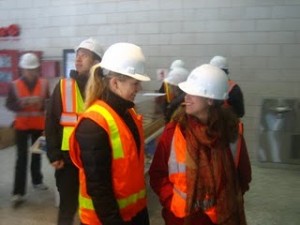 Wastewater Management Plant. Oh man did we learn a lot about the process of wastewater management from plant superintendent Jim Pynn. I’m going to share much of our new knowledge right now:
Wastewater Management Plant. Oh man did we learn a lot about the process of wastewater management from plant superintendent Jim Pynn. I’m going to share much of our new knowledge right now:
New York City has a gravity-fed wastewater system in place. It was originally an open repository until the late 1800s. Robert Moses (NYC’s planning guru) figured out that there needed to be 18 drainage areas based on population, growth, and distance. He figured out how large the pipes had to be and how many treatment plants were necessary. There are currently only 14 treatment plants because Staten Island was supposed to have six plants, but only two were built.
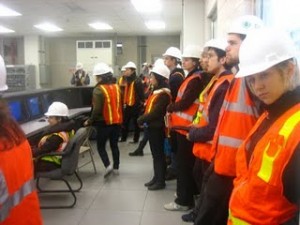 There are five major steps to wastewater treatment:
There are five major steps to wastewater treatment:
1) Screening—the material that comes through the sewer pipes are screened and the larger material is caught across a one-inch grate and then removed;
2) Sand + Silt (grit)—these substances would wear down the walls of the pipes, so they are allowed to settle to the bottom by gravity;
3) Biological Process—microorganisms feed on the incoming sewage, which takes place in settling tanks. There is waste sludge (75% of the microorganisms remain) and return sludge (25 of the microorganisms remain), and the digestors (in the iconic egg-shape here at Newtown Creek) thicken the mixture to 6% of the microorganisms remaining. The digestion process anaerobic and produces methane gas. At 27% cake (like wet sand) some of the material is sent to Colorado, Florida, Ohio and Texas where it is thrown on land to grow grass;
4) Scum—grease and oils are naturally elevated from the mixture;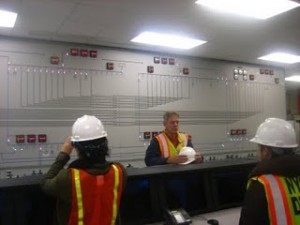
5) Kill extra microorganisms—here a 4 parts/million bleach to water concoction is added to the mixture to get rid of even the most hearty bacteria, namely fecal chloroform. Once the levels of the fecal chloroform are well below the requirements, the plant knows all the other bacteria have been eradicated as well.
The whole treatment process takes 6 hours in the plant, versus the 21 days required for similar effects to take place naturally. The final result ends up in the East River, but don’t be too grossed out—this wastewater treatment plant practically produces consumable water—if it was being cleaned for consumption, step 5 would involved UV rays rather than chlorine to kill the remaining microorganisms. And just think—before the wastewater treatment plants, pure sewage was being dumped into the East River. Which sounds better to you?!
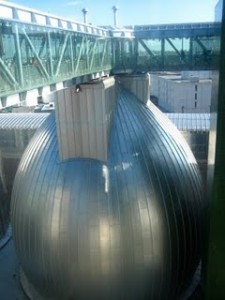 Now that we all know more than we ever wanted to about what happens after we flush our toilets, on to the tour. Polshek Partnership is redesigning master plan and main buildings of the plant, part of a larger $4.1 billion government endeavor. Its completion date is 2014, and it’s set in a contract, so there really is no wiggle room like most projects. It’s a unique project for Polsek Parternship in scale and program, but it doesn’t mean the public won’t be looking at the architecture when it’s all said and done.
Now that we all know more than we ever wanted to about what happens after we flush our toilets, on to the tour. Polshek Partnership is redesigning master plan and main buildings of the plant, part of a larger $4.1 billion government endeavor. Its completion date is 2014, and it’s set in a contract, so there really is no wiggle room like most projects. It’s a unique project for Polsek Parternship in scale and program, but it doesn’t mean the public won’t be looking at the architecture when it’s all said and done.
Starting in the visitor center, we walked to the control center part of the new main building. The computers and wall of buttons and circuits seemed straight out of a 1980 sci-fi movie, and I kept thinking that there should have been ‘bleep bloop’ beeping sounds.
Then we went to the digester service building and took the elevator up to the viewing platform. We also got to look inside a transparently covered opening down into one of the giant egg-shaped digester—ew!! Not something I’d like to see again frankly. All I’m going to say is that it had the consistency of split pea soup—use your imagination if you dare. 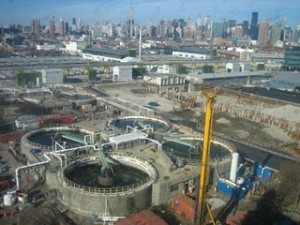
Then we went all the way down the basement that connects all the digesters underground—a network of pipes, valves, and so on. The smell was not too pleasant down here, even though the rest of the plant area was pretty odor-free, apart from some methane spots. The bottom ends of the eggs reach down into the space, completely suspended in concrete cylinders rather than having the bottoms touch the ground.
Out of the basement we were back in the fresh air, and headed to the new support building, where our guide and the plant superintendent Jim Pynn has just recently moved into his new office. The support building marks the start of the Nature Walk, a project by environmental sculpture artist George Trakas. This is open to the community from dawn to dusk, and acts as a haven, with steps bringing people right into the water. It runs along the plants water’s edge, reconnecting the people and land to Newtown Creek. This Nature Walk is part of the Percent for Art program, commissioning artists to create permanent public artworks in municipal buildings 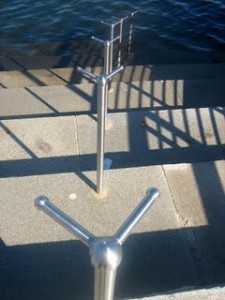 and spaces throughout the city.
and spaces throughout the city.
Parting thoughts:
-9am is the busiest time for the Newtown Creek WWTP, when everyone arrives in their office buildings and uses the restrooms—9am rush hour? More like 9am flush hour!
-If you flush the toilet or take a shower, etc. on the upper west side, it takes about 45 minutes to reach the Newtown Creek WWTP.
-Without wastewater treatment plants we would be ridden with epidemics of dysentery and cholera and would not be the United States as we know it. So they’re kind of a big deal.

